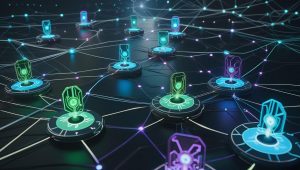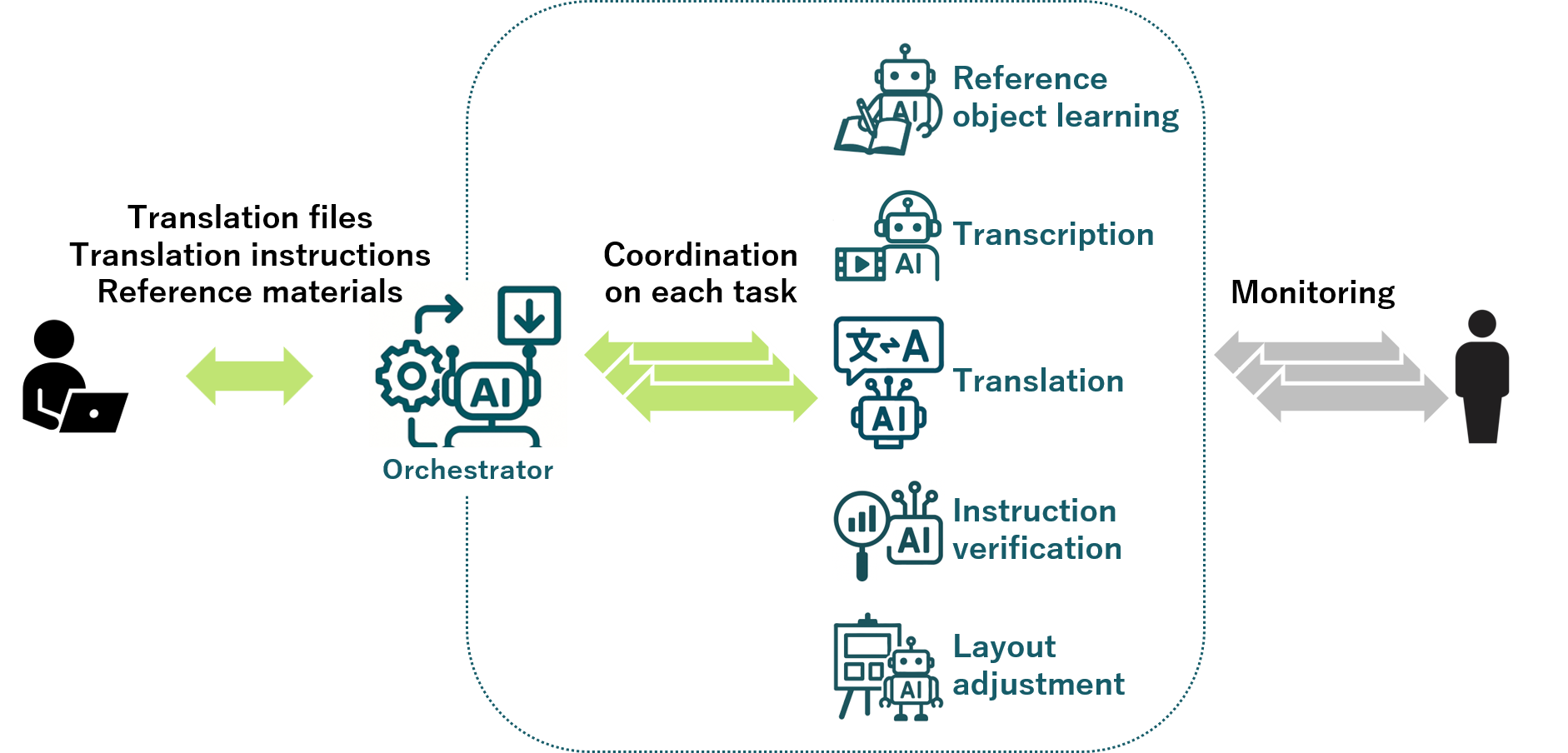How AI is Changing Translation Workflows
— A System that Balances both Speed and Quality

The widespread adoption of AI and related technologies is bringing significant changes to translation workflows. Among the various emerging technologies and services, Toin is advancing the use of a "Multi-Agent System (MAS)." This article explores a translation workflow that utilizes this technology, highlighting its advantages and considerations, as well as the appropriate role that humans should play in it.
What is a Multi-Agent System?
A multi-agent system refers to a framework composed of multiple AI agents that perform tasks on behalf of users or systems to achieve specific objectives. Each AI agent functions like a member of a specialized team of experts, possessing its own distinct skills.
In the field of translation, various AI agents work collaboratively to handle tasks such as studying style guides and glossaries, converting a variety of file formats into translation-ready formats, translating the content, and adjusting the layout. Overseeing and coordinating these AI agents is an AI called the "orchestrator," which manages the workflow to ensure smooth progress throughout the translation process.
From Manual Operations to AI, and Towards Automation through Multi-Agent Systems
In a typical human-centered translation project, the coordinator plays a central role by assigning tasks to specialists in various fields, such as translators, reviewers, and DTP operators. With the growing prevalence of machine translation and AI, certain individual tasks such as translation and review are increasingly being performed by AI. However, the coordination between tasks and overall project management continues to depend on humans. While some workflow automation is done through translation management systems, this is generally limited to projects of a certain scale or larger.
The multi-agent system advances the workflow to its next stage. Upon receiving task instructions, the system analyzes their content and coordinates with the necessary AI agents to conduct a series of operations.
Automation of a Custom-Designed Translation Workflow
The strength of a multi-agent system lies not only in its ability to automatically translate files, but also in its ability to define translation workflows tailored to the specific requirements of each project. Even without additional training of the core AI, it is possible to exert a certain degree of control over the AI's behavior by providing precise translation instructions and reference materials.
For example, it is possible to ensure the correct translation of specific proper nouns such as company or product names, as well as to specify a writing style that aligns with the brand image. In addition, media-specific rules such as omitting punctuation in subtitle translations can also be applied, thereby enabling truly customized, order-made automated translations.

Evolving Role and Added Value of Increasingly Advanced “Human Capital”
Does automation of processes mean that the role of humans will disappear? Certainly not. On the contrary, the role of humans will shift toward increasingly specialized and advanced responsibilities. The most critical skill is the ability to create precise instructions for AI—that is, the ability to clearly define and articulate the goals of a translation, and to prepare supporting materials such as guidelines and glossaries that will guide the process toward those goals. While AI can faithfully execute the instructions it is given, it is ultimately up to humans to determine what constitutes a "good translation."
Moreover, continuously monitoring the performance of AI agents and making the necessary adjustments to maintain and improve their quality is an important added value that only humans can provide.
Advantages and Important Considerations
●Translation workflows utilizing a multi-agent system offer the following advantages:
- 1. Achieve high speed and cost efficiency
By automating the translation workflow, it is possible to produce translated content more quickly while also reducing costs. - 2. Quality control
Terminology, proper nouns, fixed expressions, and writing style can be defined for each project, enabling effective quality control. - 3. Accumulate expertise in the latest technologies
The expertise of platform providers can be leveraged in evaluating and selecting AI technologies, which are characterized by rapid evolution and generational changes.
●However, there are certain important considerations to keep in mind when utilizing the system:
- 1. Automating the translation workflow requires a certain level of preparation
Automating the translation workflow, starting with organizing guidelines and glossaries, requires a certain level of preparation. While it is possible to proceed without such preparation, doing so would involve delegating many decisions to AI, making it uncertain whether the output will fully meet the project’s requirements. - 2. Human support requires preparation
While it may not be practical to check every part of the process, it is important to have a system and environment in place that allows for prompt human intervention in the event of unexpected outputs. It is also advisable to consult with platform and service providers in advance.
We will be providing a detailed explanation of these advantages and important considerations in our next article, so please look forward to it.
▶About the Author
TOIN Corporation, Translation & Localization Dept., Sales 1 Section
Takao Tanaka
Active at the forefront of the global translation industry, leading operations, sales, and solution development for enterprise localization projects. Subsequently, he contributed to technological innovation shaping the future of the industry at a tech company specializing in AI translation and cutting-edge related technologies. In 2024, he joined TOIN Corporation to help establish a next-generation translation service that maximizes the synergy between technology and human expertise. Striving to achieve both efficiency and quality, he is helping us set a new standard in global communication.









